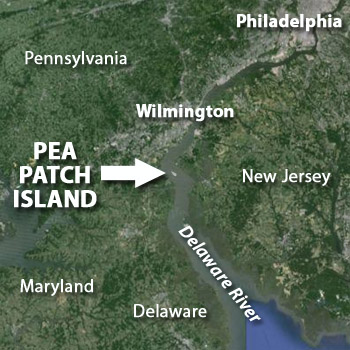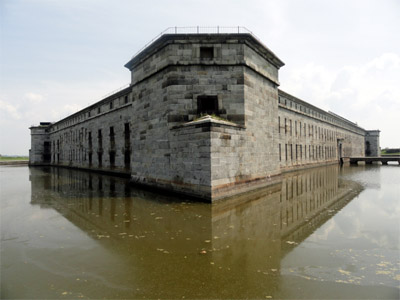 |
Fort Delaware
Pea Patch Island, Delaware
|
|
 |
Constructed: 1848-1859
Used by: USA
Conflict in which it participated: US Civil War
|
Fort Delaware, sited to defend the dockyards of Wilmington and Philadelphia in the mid-18th century, exists today as a stellar representation of two distinct eras of American seacoast defense.
Pierre Charles L'Enfant (1754-1825) was a French engineer who joined up with the rebellious colonists in 1777 to fight the British in the American Revolutionary War. L'Enfant spent time on George Washington (1732-1799)'s staff, and was at Valley Forge, where he painted a portrait of his commanding officer. After the war, L'Enfant designed the layout of Washington, D.C. that still defines that city today. |
 |
 |
|
While still in the process of trying to convince Congress to actually pay him for his work on their city, in 1794 L'Enfant was boating up the Delaware River, looking for likely spots to fortify in the interest of defending the ports of Wilmington and Philadelphia from seaborne marauding British hordes. On this mission, he and his crew happened across an island he charmingly called Pip Ash...L'Enfant had discovered Pea Patch Island (imagine L'Enfant reporting to Congress that he'd found the perfect spot for fortification: Pip Ash! Whereupon clerks would be furiously trying to find where Pip Ash was on a map), which was perfect in every way for his fortification purposes, EXCEPT...it belonged to a guy from New Jersey named Dr. Henry Gale.
Gale used Pea Patch Island as his private hunting ground, and turned down the US military's offer of $30,000. The military was DETERMINED to use Pip Ash for their reindeer games, however, and appealed to the Delaware state legislature, which nabbed the island for the military on May 27, 1813. That's what you get, Dr. No-thanks-for-thirty-grand Gales!
|
| The three intended incarnations of Fort Delaware: The original lovely star design, the weird big thing, and the polygonal wonder that it is today. |
 |
Construction on the first iteration of Fort Delaware began in early 1817, overseen by Chief Engineer Joseph Gardner Smith (1783-1865). The fort was to be built in the classic five-pointed star design that we know and love, progressed nicely and was mostly complete by 1823, but issues with Pea Patch Island's marshy environment delayed its completion for several years.
The US Army Corps of Engineers sent a Lieutenant Tuttle to investigate the delay, but instead of helping, Tuttle somehow managed to start a fire in his quarters on February 8, 1831, destroying the fort's plans and killing Fort Delaware's starrish aspirations. What had been built was torn down in 1833, and the rubble was used to reinforce Pea Patch Island's seawall.
The Army's new Chief Engineer, Richard Delafield (1758-1863), was determined to "erect a marvel of military architecture on Pea Patch." |
|
|
A huge triangular monstrosity fort was designed (slightly reminiscent of Fort Caroline at Jacksonville, Florida, but nowhere near as pretty), but legal battles regarding the island's legal ownership (Dr. Gales strikes back!) kept anything past foundations from being built for over 10 years.
|
Finally the Government either won the legal battle or quietly disposed of Dr. Gales, and the Fort Delaware that we see today was erected from 1848 to 1859. At the time, Fort Delaware was the largest (and most expensive!) fortification in the US. It was also, according to the guide at the fort when I visited in 2012, the first structure in the United States to enjoy indoor plumbing!
A young Captain by the name of George B. McClellan (1826-1885) was involved in the construction of Fort Delaware. McClellan would go on to lead the Union Army in a not particularly stellar fashion during the US Civil War (1861-1865).
With prisoners taken during the First Battle of Kernstown (March 23 1862), the Union Army began sending Confederate POWs, convicted Federal soldiers, and local "southern sympathizers" to Fort Delaware for imprisonment in 1862.
|
 |
Fort Delaware has lots of guns still mounted. Here on the fort's most heroic bastion, the northwest, sits an 8-inch Columbiad gun that is fired daily, just to keep New Jersey from getting any ideas. |
|
Wooden barracks were built for this purpose all over the island, and by August of 1863 there were some 11,000 prisoners there. Most of the Confederate prisoners taken at the Battle of Gettysburg (July 1-3, 1863) were held at Fort Delaware.
By the end of the war, around 33,000 prisoners had spent time at Fort Delaware, of whom about 2,400 died in captivity. This is indeed most unpleasant, but given the era and conditions, Fort Delaware was a much healthier place to be than many other Civil War prison camps: Fort Sumter at Andersonville Georgia, for example, held some 45,000 Union prisoners in its just over one year of existence, of whom nearly 13,000 died: Camp Rathburn at Elmira, New York, held just over 12,000 Confederate prisoners from 1864 to 1865, of whom nearly 3,000 died.
|
 For Delaware's heroic southwest bastion, posing in a way that it has posed for anyone who's shown up with a camera for the past 150 years. |
 |
One notable prisoner at Fort Delaware was a 14-year-old Confederate soldier named Private Bailey Peyton Key, who was the youngest Confederate combatant to be captured during the war. Bunton S. Harrison, personal secretary to Confederate President Jefferson Davis (1808-1889), was Fort Delaware's last Civil War prisoner, and was released in January of 1866. In 1870 the fort's garrison was withdrawn, laving behind a small caretaker force. In the 1890's, the Endicott Board determined that lots and lots of fresh concrete needed to be liberally slathered both upon, and in the vicinity of, America's existing seacoast defenses. |
|
|
Many American starforts had new modern gun batteries built in or next to them thanks to this government largesse, but few were defaced as was Fort Delaware.
As you will no doubt have noticed from the picture at the top of this page, about a third of Fort Delaware today is monochromatic concrete, while the rest is lovely Civil War-era brick. This makes for a stark difference in both appearance and function, as the giant modern guns that needed to operate on Pea Patch Island in order to deter those scary European powers of the end of the 19th century had to be supported by steel and concrete, not crumbly little bricks. Bricks were better at absorbing incoming fire without producing deadly shrapnel than they were at holding up the untold tons of steel of late-19th-century guns.
Battery Torbert, mounting three massive 12" guns, was completed in 1901 and served as Fort Delaware's main battery: Batteries Alburtis and Allen, each mounting two 3" guns, were also build within the fort, at either end of Battery Torbert. Batteries Hentig and Dodd, each with two smallish guns, were built just outside the fort's walls at this time as well.
During the First World War (1914-1918), Fort Delaware was again garrisoned from 1917 to 1919, in case the Imperial German Navy made a dash for Philadelphia's shipyards. Another force garrisoned the fort following the Japanese attack on Pearl Harbor (December 7, 1941) and hung out for most of the Second World War (1939-1945), but abandoned the fort in 1944.
The state of Delaware took possession of the fort in 1947, and officially made all of Pea Patch Island into Fort Delaware State Park in 1951.
|
Today, visitors can reach Pea Patch Island by ferry. Daily activities include folks in Civil War period dress, bustling around and doing Civil War period things, and there is a daily firing of an 8 inch Columbiad gun. In the second week of June each year, there is an "Escape from Fort Delaware" triathalon, in which competitors leap into the river while being fired upon by muskets (or maybe that musket shot just starts the race), swim to the shore and run and ride bikes to the town green in Delaware City: This to commemorate some 52 Confederate escapees during the Civil War. Or if not to commemorate, to at least follow in the armstrokes and footsteps of. Any Civil War-era prison is bound to have plenty of ghosts inhabiting its passageways (at least they're there if you really want them to be), so "Paranormal Tours" are also available at Fort Delaware. Both US and British television have aired shows regarding the supposed paranormal activity at Fort Delaware in recent years. I visited Fort Delaware in 2012! Please see the Fort Delaware page in our Starforts I've Visited section to peruse pix and read my impressions!
|
 |
Pea Patch Island, 40 miles down the Delaware from Philadelphia, got its name thanks to an early 18th century shipwreck that dumped a cargo of peas thereon. These peas, released from human oversight, created their own civilization on the island, which flourished until people showed up and ate them. |
|
|
|
|
|
|
 |




